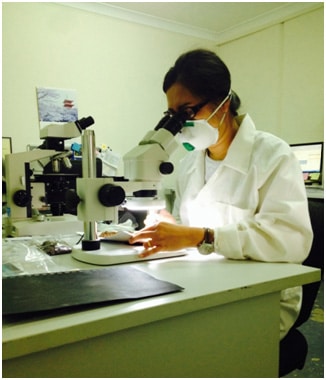How to Eliminate Mold From Every Home Surface
Mold spores are all over around us in every type of climate. Mold is fungis and some types are incredibly advantageous to mankind (think https://local.google.com/place?id=7127076264936816522&use=srp&gl=us&hl=en about penicillin), while others can be rather dangerous to crops, breathing systems, and the stability of structures. Unsafe Mold vs. Mildew The most typical type of mold found in homes is mildew.
Mildew is a surface mold that grows in warm, damp places like your bathroom and on fabrics and books saved in damp basements. Mildew starts as a gray or white grainy colony. It will turn black or brown if not gotten rid of without delay and typically appears like soil build-up. To evaluate if the surface is covered with mildew or simply dirt, dab the stain with a cotton bud dipped in home chlorine bleach. If the stain lightens or vanishes after two or three minutes, it's mildew. If not, it's most likely simply dirt. If you discover a musty smell anywhere in your home, then you have a high concentration of mold. It can be coming from a hinder filled with damp towels, from a moist crawlspace under your home, or carpets that have mold growing in the cushioning. It's absolutely time to take action to get rid of the problem. Now you know that all mildew is mold but not all molds are mildew.
Mildew can tarnish and slowly harm surfaces however there are a lot more dangerous molds that can damage the structure of your home. If you see a black or green mold that is fuzzy or slimy and the drywall or wood below is soft or falls apart, there is permanent rot and the mold and the broken surface areas need to be removed instantly.
Working with Experts If mildew infestation is caught early, you can easily handle it with home cleaners.
Caution For comprehensive mold problems, think about employing a professional. Some molds are highly hazardous and even less harmful molds can cause issues for anyone with mold allergic reactions or compromised breathing systems. The general rule is if the mold covers 10 or more square feet, employ an expert. Getting rid of large mold nests needs direct exposure to durable chemicals and correct disposal of plagued structure products.
Regional public health departments can use suggestions on mold testing and refer you to an expert mold cleaner.

Products That Eliminate Mold Chlorine bleach: Sodium hypochlorite or routine household bleach works best to damage mold and remove any staining. It is quite harsh and should be diluted before using.
Caution Caution must be used due to toxicity and harmful fumes and bleach needs to never be integrated with ammonia.
Hydrogen peroxide: Less harsh than chlorine bleach, hydrogen peroxide (3 to 10 percent option) will eliminate mold and lighten spots. While it does have a whitening impact, it works more gradually than chlorine bleach but has no hazardous fumes or residue.
Distilled white vinegar: Vinegar is acidic and gradually breaks down the structure of mold and kills it. Vinegar is non-toxic but mold discolorations may stay and extra scrubbing with a household cleaner might be needed.
Sodium bicarbonate and borax: Sodium bicarbonate (baking soda) and borax each have a high pH that hinders the growth and survival of mold. Both items are affordable, non-toxic, and simple to combine with water. Borax will work much better in getting rid of any lingering spots however not as successfully as a stronger cleansing item. When using any of these products, do not wash away the cleaning solution entirely. Leaving a little bit of the cleaner will assist inhibit future mold growth.
Removal from Material If your house has been flooded and mold and bacteria have been delegated grow for many days, it may be difficult to restore fabric items. Nevertheless, if mildew has actually developed due to wetness and is caught early, it can easily be eliminated from many materials. Begin by taking the products outside to brush away as much surface area mold as possible and to prevent spreading out the mold spores inside your house. If the fabric is washable, use the most popular water recommended on the care label and include a disinfectant. If discolorations remain, produce a service of oxygen bleach and water and permit the clothing to soak for a minimum of eight hours.
Oxygen bleach can be used safely on any washable fabric. For fabrics that are dry tidy just, brush away the mildew outdoors and after that head to an expert cleaner. http://www.thefreedictionary.com/Mold inspection Recognize and explain the stains and most fabrics can be effectively brought back.
Leather Shoes, Coats, Add-on, and Furnishings Mold on leather coats, shoes, purses, and furnishings needs to be gotten rid of outside, if possible. Wipe down the surface area with a fabric dipped in distilled white vinegar and then https://foursquare.com/v/precision-environmental-services/5ddeba8791dc9d0007d37f0f with an excellent leather soap and warm water. Dry with a soft cloth and allow to air dry totally. When entirely dry, deal with the item with a leather conditioner.
Books and Documents Mold will eventually destroy paper but it can be effectively removed. For expensive books and historically considerable papers, speak with an expert manager. Never attempt to treat wet paper. The mold will smear and become almost difficult to eliminate. Allow the paper in books to air dry completely in the sun or location in a sealed container with wetness absorbent material like silica gel or cornstarch sprinkled between the pages. When the book is dry, head outside and utilize a soft paintbrush or cloth to gently brush away the mildew from the cover and each page. Slide a sheet of waxed paper under each page to safeguard the page behind it. Somewhat dampen a clean, soft cloth with hydrogen peroxide and carefully clean down each page permitting it to air dry entirely before relocating to the next page.